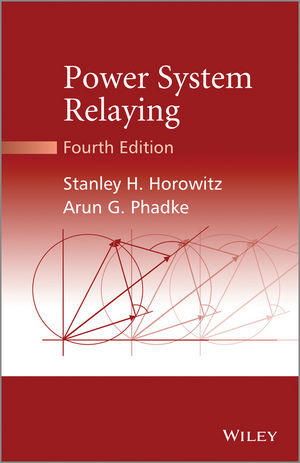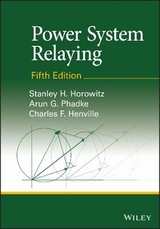
Power System Relaying 4e
John Wiley & Sons Inc (Verlag)
978-1-118-66200-7 (ISBN)
- Titel erscheint in neuer Auflage
- Artikel merken
Used by universities and industry courses throughout the world, Power System Relaying is an essential text for graduate students in electric power engineering and a reference for practising relay and protection engineers who want to be kept up to date with the latest advances in the industry.
Stanley H. Horowitz, Retired Consulting Engineer, American Electric Power, BSEE City College of New York. Mr Horowitz worked at American Electric Power Service Corp. from 1950 to 1989, serving as head of the System Protection Section and assistant head of the Electrical Engineering Division and Consulting Electrical Engineer.?He was a lecturer at Columbia University Graduate School and a guest lecturer at the Universities of Wisconsin, Marquette, Auburn, Virginia Polytechnic Institute, Rensselaer Polytechnic Institute, Massachusetts Institute of Technology, Lund University and Grenoble University. He is a Life Fellow of the IEEE and served as chairman of the IEEE/PES Power System Relaying Committee from 1975-1978. In 1995 he was elected to the National Academy of Engineering and in 2008 was awarded the PES Life Achievement Award. Mr Horowitz was chairman of Study Committee 34-Protection and Control of the International Conference on Large High Voltage Electric Systems (CIGRE) from 1980-1986. In 1997 he was awarded the CIGRE Attwood Associates Award. He has co-authored a textbook and authored over 24 technical papers; he was also editor-in-chief of the IEEE Power Engineering Society magazine "Computer Applications in Power" until 2002. Arun G. Phadke, Retired Research University Distinguished Professor, Virginia Technical University, Life Fellow-IEEE, member National Academy of Engineering
Preface to the Fourth Edition xi Preface to the Third Edition xii Preface to the Second Edition xiii Preface to the First Edition xiv 1 Introduction to Protective Relaying 1 1.1 What is Relaying? 1 1.2 Power System Structural Considerations 2 1.3 Power System Bus Configurations 4 1.4 The Nature of Relaying 8 1.5 Elements of a Protection System 14 1.6 International Practices 18 1.7 Summary 19 Problems 19 References 23 2 Relay Operating Principles 25 2.1 Introduction 25 2.2 Detection of Faults 26 2.3 Relay Designs 30 2.4 Electromechanical Relays 31 2.5 Solid-State Relays 40 2.6 Computer Relays 44 2.7 Other Relay Design Considerations 45 2.8 Control Circuits: A Beginning 48 2.9 Summary 49 Problems 49 References 51 3 Current and Voltage Transformers 53 3.1 Introduction 53 3.2 Steady-State Performance of Current Transformers 54 3.3 Transient Performance of Current Transformers 61 3.4 Special Connections of Current Transformers 64 3.5 Linear Couplers and Electronic Current Transformers 67 3.6 Voltage Transformers 68 3.7 Coupling Capacitor Voltage Transformers 69 3.8 Transient Performance of CCVTs 72 3.9 Electronic Voltage Transformers 75 3.10 Summary 76 Problems 76 References 78 4 Nonpilot Overcurrent Protection of Transmission Lines 79 4.1 Introduction 79 4.2 Fuses, Sectionalizers, and Reclosers 81 4.3 Inverse, Time-Delay Overcurrent Relays 84 4.4 Instantaneous Overcurrent Relays 94 4.5 Directional Overcurrent Relays 96 4.6 Polarizing 98 4.7 Summary 102 Problems 102 References 105 5 Nonpilot Distance Protection of Transmission Lines 107 5.1 Introduction 107 5.2 Stepped Distance Protection 107 5.3 R X Diagram 110 5.4 Three-Phase Distance Relays 114 5.5 Distance Relay Types 123 5.6 Relay Operation with Zero Voltage 124 5.7 Polyphase Relays 125 5.8 Relays for Multiterminal Lines 126 5.9 Protection of Parallel Lines 129 5.10 Effect of Transmission Line Compensation Devices 132 5.11 Loadability of Relays 134 5.12 Summary 136 Problems 136 References 138 6 Pilot Protection of Transmission Lines 139 6.1 Introduction 139 6.2 Communication Channels 140 6.3 Tripping Versus Blocking 144 6.4 Directional Comparison Blocking 145 6.5 Directional Comparison Unblocking 149 6.6 Underreaching Transfer Trip 150 6.7 Permissive Overreaching Transfer Trip 153 6.8 Permissive Underreaching Transfer Trip 154 6.9 Phase Comparison Relaying 155 6.10 Current Differential 158 6.11 Pilot Wire Relaying 159 6.12 Multiterminal Lines 160 6.13 The Smart Grid 163 6.14 Summary 163 Problems 164 References 165 7 Rotating Machinery Protection 167 7.1 Introduction 167 7.2 Stator Faults 168 7.3 Rotor Faults 183 7.4 Unbalanced Currents 184 7.5 Overload 184 7.6 Overspeed 186 7.7 Abnormal Voltages and Frequencies 187 7.8 Loss of Excitation 188 7.9 Loss of Synchronism 189 7.10 Power Plant Auxiliary System 190 7.11 Winding Connections 196 7.12 Startup and Motoring 196 7.13 Inadvertent Energization 198 7.14 Torsional Vibration 200 7.15 Sequential Tripping 200 7.16 Summary 201 Problems 202 References 204 8 Transformer Protection 207 8.1 Introduction 207 8.2 Overcurrent Protection 208 8.3 Percentage Differential Protection 210 8.4 Causes of False Differential Currents 213 8.5 Supervised Differential Relays 219 8.6 Three-Phase Transformer Protection 221 8.7 Volts-per-Hertz Protection 226 8.8 Nonelectrical Protection 227 8.9 Protection Systems for Transformers 228 8.10 Summary 234 Problems 234 References 236 9 Bus, Reactor, and Capacitor Protection 237 9.1 Introduction to Bus Protection 237 9.2 Overcurrent Relays 238 9.3 Percentage Differential Relays 238 9.4 High-Impedance Voltage Relays 239 9.5 Moderately High-Impedance Relay 241 9.6 Linear Couplers 241 9.7 Directional Comparison 242 9.8 Partial Differential Protection 243 9.9 Introduction to Shunt Reactor Protection 244 9.10 Dry-Type Reactors 245 9.11 Oil-Immersed Reactors 247 9.12 Introduction to Shunt Capacitor Bank Protection 248 9.13 Static Var Compensator Protection 250 9.14 Static Compensator 252 9.15 Summary 252 Problems 253 References 254 10 Power System Phenomena and Relaying Considerations 255 10.1 Introduction 255 10.2 Power System Stability 255 10.3 Steady-State Stability 256 10.4 Transient Stability 261 10.5 Voltage Stability 266 10.6 Dynamics of System Frequency 267 10.7 Series Capacitors and Reactors 270 10.8 Independent Power Producers 271 10.9 Islanding 272 10.10 Blackouts and Restoration 272 10.11 Summary 275 Problems 275 References 276 11 Relaying for System Performance 277 11.1 Introduction 277 11.2 System Integrity Protection Schemes 277 11.3 Underfrequency Load Shedding 278 11.4 Undervoltage Load Shedding 280 11.5 Out-of-Step Relaying 281 11.6 Loss-of-Field Relaying 285 11.7 Adaptive relaying 285 11.8 Hidden Failures 288 11.9 Distance Relay Polarizing 289 11.10 Summary 292 Problems 292 References 292 12 Switching Schemes and Procedures 293 12.1 Introduction 293 12.2 Relay Testing 293 12.3 Computer Programs for Relay Setting 295 12.4 Breaker Failure Relaying 296 12.5 Reclosing 299 12.6 Single-Phase Operation 300 12.7 Summary 300 References 300 13 Monitoring Performance of Power Systems 301 13.1 Introduction 301 13.2 Oscillograph Analysis 302 13.3 Synchronized Sampling 309 13.4 Fault Location 311 13.5 Alarms 316 13.6 COMTRADE and SYNCHROPHASOR Standards 318 13.7 Summary 319 Problems 320 References 322 14 Improved Protection with Wide Area Measurements (WAMS) 323 14.1 Introduction 323 14.2 WAMS Organization 323 14.3 Using WAMS for Protection 324 14.4 Supervising Backup Protection 326 14.5 Impedance Excursions into Relay Settings 327 14.6 Stability-Related Protections 328 14.7 SIPS and Control with WAMS 333 14.8 Summary and Future Prospects 334 References 334 15 Protection Considerations for Renewable Resources 337 James K. Niemira, P.E. 15.1 Introduction 337 15.2 Types of Renewable Generation 337 15.3 Connections to the Power Grid and Protection Considerations 344 15.4 Grid Codes for Connection of Renewables 351 15.5 Summary 355 References 355 Appendix A: IEEE Device Numbers and Functions 357 Appendix B: Symmetrical Components 359 Appendix C: Power Equipment Parameters 365 Appendix D: Inverse Time Overcurrent Relay Characteristics 369 Index 373
| Erscheint lt. Verlag | 28.1.2014 |
|---|---|
| Verlagsort | New York |
| Sprache | englisch |
| Maße | 170 x 244 mm |
| Gewicht | 754 g |
| Themenwelt | Technik ► Elektrotechnik / Energietechnik |
| ISBN-10 | 1-118-66200-8 / 1118662008 |
| ISBN-13 | 978-1-118-66200-7 / 9781118662007 |
| Zustand | Neuware |
| Haben Sie eine Frage zum Produkt? |
aus dem Bereich



